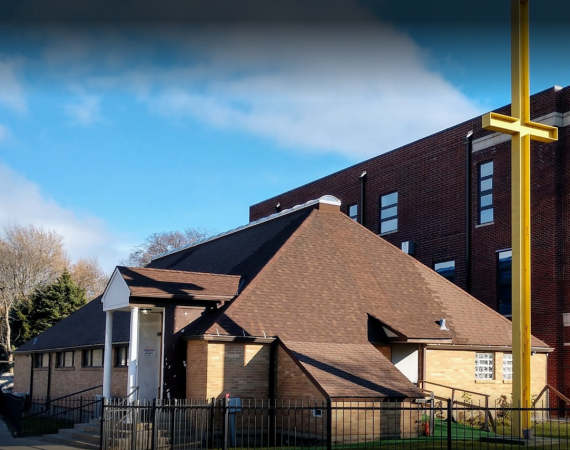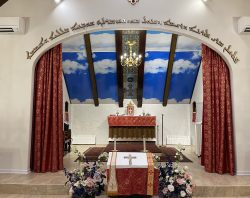About Saint John ChurchWelcome to Saint John Church


St. John Church of the Holy Apostolic Catholic Assyrian Church of the East A synopsis of the history of St. John Church.
June, 2017 marked the 50 year anniversary of the opening of St. John Church at its present location, 1421 W. Lawrence Avenue, Chicago, Illinois. The previous location of the Church was at 2247 N. Halsted Street, Chicago, Illinois.
The Church was established in 1943 as a result of a dispute dating back to the early 1930s between members of the Church of the East. The dispute finally culminated in splitting the members into two factions, those pledging allegiance to Mar Eshai Shimun and the second group promising loyalty to Rev. Sadook de Mar Shimun, the majority of whom were English speaking Assyrians.
On January 15, 1944, the Free Holy Catholic Apostolic Church of the East of America, Inc. was incorporated and church services, led by Rev. Sadook de Mar Shimun, were held at the newly purchased building on Halsted Street, Chicago.
Over the following few years, the Church adopted and used several names to identify its self, including the following:
- The Free Holy Catholic Apostolic Church, Assyrian American (1944)
- The Free Holy Catholic Apostolic Church (1947)
- St. John’s Assyrian Church Apostolic Free Nestorian Church (1948)
- St. John’s Assyrian American Church Apostolic Church (1950s)
- St. John’s Free Holy Assyrian American Apostolic Church (1960s)
- St. John’s Church of the Holy Apostolic Catholic Assyrian Church of the East (1977).
During the late 1950’s and early 1960’s, fueled by their strong philanthropic drive and Assyrian identity, the Church parishioners established several organizations, including the Ladies Aid Society of St. John Church, a Youth Club, a Church Brotherhood Association and the Laymen Church Society.
By the mid 1960’s, however, membership was declining and the church building was in dire need of major repairs. Faced with the financial burdens, the parishioners decided to relocate to a smaller church. With a generous donation by Helen Odeshoo, a vacant lot was purchased at the corner of Lawrence Avenue and Dover Street to build the new church.
In 1966, construction for the new home of St. John began and the church structure was completed in 1967. Donations and contributions by the parishioners poured in wholeheartedly and helped equip the church with much needed furniture and furnishings such as the pews, baptismal fond, crosses and an organ.
For the next decade and half, St. John’s Church sustained itself through membership dues and social activities such as picnics, dinner events, movie nights and bowling outings. However, due to the “natural attrition of life and the fact that many of the younger generation moved to the suburbs”, membership gradually diminished which, once again, heightened the financial hardships. It was apparent that sustaining the parish perpetually was becoming difficult, if not impossible. That, and the death of Rev. Sadook in June, 1986, was a turning point for the Church’s surviving members. Faced with the hard choice of either selling the property and dissolving the Church altogether or merging with other Christian denominations, the parishioners chose the latter. So in the late 1980’s and early 1990’s, the church committee (known as the Elders) began merger negotiations with other churches and individuals such as the Moody Bible Institute, Peter Talya of the Assyrian Evangelical Covenant Church, Mar Odishoo Church and the late Rev. Gouliat. Merger negotiations also ensued with the mother church, the Holy Apostolic Catholic Assyrian Church of the East.
On February, 1977, a Merger Agreement was signed by and between Mar Aprim Kamis, Bishop of the Holy Apostolic Catholic Assyrian Church of the East and, with the unanimous approval of its parishioners, by Herbert Atanus and Norman Odeshoo, as representatives of St. John’s Church. Some points agreed upon by the two Churches were that Rev. Charles Klutz, who at the time was serving as a temporary priest, become the official parish priest of the Church, sacerdotal services be conducted in English, the Church property be deeded to the Church of the East and the original donated furnishings and equipment by the members be retained and preserved.
The tragic events of September 11, 2001 triggered an arson attack on the Church on September 23, 2001 by unknown assailants resulting in minimal property damage and no personal injury.
Today, under the spiritual guidance of Rev. Antwan Latchen, St. John’s Church is once again undergoing rejuvenation and spiritual revival. Since his arrival, after the retirement of Rev. Klutz in 2008, the Church has seen a steady increase in its membership, including Assyrians of American descent, Assyrians from the motherlands and non-Assyrians. The dual language (Assyrian and English) Eucharist services, as well as weddings and baptisms, have also attracted multicultural participants to fulfill their spiritual needs.
With the many challenges still lying ahead, the faithful parishioners of St. John’s Church continue to forge ahead to preserve and pass onward their Christian faith and love of the Mother Church to their children, grandchildren and generations to come.